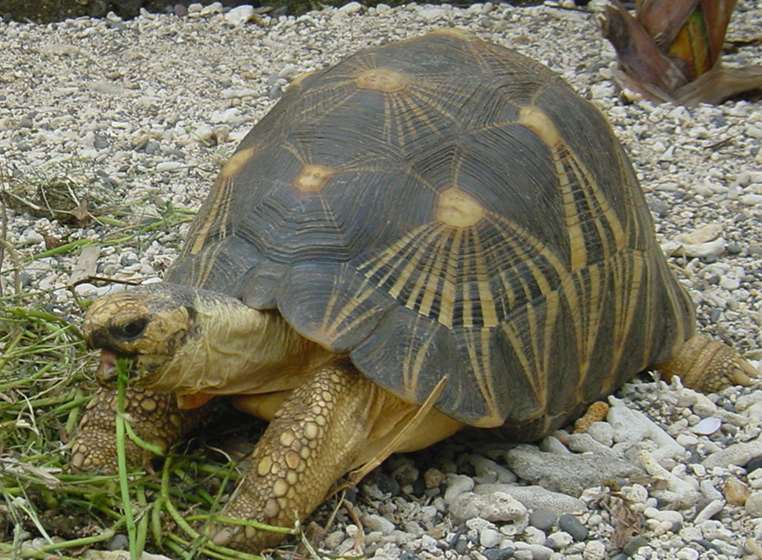- Radiated tortoise
Taxobox
name = Radiated tortoise
status = VU
status_system = iucn2.3
status_ref =IUCN2006|assessors=Tortoise & Freshwater Turtle Specialist Group|year=1996|id=9014|title=Geochelone radiata|downloaded=11 May 2006 Listed as Vulnerable (VU A1acd+2cd, B1+2abc v2.3) ]

image_width = 200px
regnum =Animal ia
phylum =Chordata
classis = Sauropsida
ordo = Testudines
subordo =Cryptodira
familia =Testudinidae
genus = "Astrochelys "
species = "A. radiata"
binomial = "Astrochelys radiata"
binomial_authority = Shaw,1802 The Radiated tortoise ("Astrochelys radiata") is aspecies in thegenus of the "Astrochelys " tortoises. [Fritz, U. & O. R. P. Bininda-Emonds 2007. "When genes meet nomenclature: Tortoise phylogeny and the shifting generic concepts of "Testudo" and "Geochelone"." Zoology 110, pages 298-307.] It is fairly large and considered to be one of the most beautifultortoise s in the world.Egeler, 2000] Although this species is native only to SouthernMadagascar and mostly only found there, it can be found in the rest of this country and has been introduced to the islands ofRéunion andMauritius . EMYSystem Species Page ] As the Radiated Tortoises areherbivore s,grazing constitutes 80-90% of their diet, while they also eatfruit s andsucculent plant s. These tortoises are, however, endangered, mainly because of the destruction of their habitat byhuman s and because ofpoaching .The oldest tortoise ever recorded, indeed the oldest reptile ever recorded, was a radiated tortoise,
Tu'i Malila , which attained the age of 188.Description
Growing to a carapace length of up to 16 inches (41 cm) and weighing up to 35 pounds (16kg), the radiated tortoise is considered to be one of the world's most beautiful tortoises.
This tortoise has the basic "tortoise" body shape, which consists of the high-domed carapace, a blunt head, and elephantine feet. The legs, feet, and head are yellow except for a variably sized black patch on top of the head.
The carapace of the radiated tortoise is brilliantly marked with yellow lines radiating from the center of each dark plate of the shell, hence its name. This "star" pattern is more finely detailed and intricate than the normal pattern of other star-patterned tortoise species, such as G. elegans of India.
The radiated tortoise is also larger than G. elegans, and the scutes of the carapace are smooth, and not raised up into a bumpy, pyramidal shape as is commonly seen in the latter species. There is slight sexual dimorphism. Compared to females, male radiated tortoises usually have longer tails and the notch in the plastron beneath the tail is more noticeable.
Distribution and Habitat
Radiated tortoises occur naturally only in the extreme southern and southwestern part of the island of Madagascar. They have also been introduced to the nearby island of Reunion.
They prefer dry regions of brush, thorn (Diderae) forests and woodlands of southern Madagascar.
Diet
The radiated tortoise is a grazing herbivore. They feed during the day primarily on grasses, fruit and succulent plants, which form 80 to 90 percent of their diet. A favorite food in the wild is the Opuntia cactus. They are known to graze regularly in the same area, thus keeping the vegetation in that area closely trimmed. They seem to prefer new growth rather than mature growth because of the high-protein, low-fiber content.
Reproduction
Males first mate upon attaining lengths of about 12 inches (31 cm); females may need to be a few inches longer. The male begins this fairly noisy procedure by bobbing his head and smelling the female's hind legs and cloaca. In some cases the male may lift the female up with the front edge of his shell to keep her from moving away.
The male then proceeds to mount the female from the rear while striking the anal region of his plastron against the female’s carapace. Hissing and grunting by the male during mating is common. Females lay from three to 12 eggs in a pre-excavated hole six to eight inches (15 to 20 cm) deep and then depart.
Incubation is quite long in this species, lasting usually between five and eight months. Juveniles are between 1.25 to 1.6 inches (3.2 to 4 cm) upon hatching. Unlike the yellow coloration of the adults, the juveniles are a white to an off-white shade. Juveniles attain the high-domed carapace soon after hatching.
Lifespan and Endangerment Status
Radiated tortoises may live as long as 40 to 50 years.
Unfortunately, these tortoises are severely endangered due to loss of habitat, being poached for food, and being over exploited in the pet trade. It is listed in Appendix I of CITES, which prohibits the import or export of the species under most conditions. However, due to the poor economic conditions of Madagascar, many of the laws are largely ignored.
No estimates of wild populations are available, but their numbers are declining, and many authorities see the potential for a rapid decline to extinction in the wild. In the North American studbook, 332 specimens are listed as participating in captive breeding programs such as the SSP. Captive breeding has shown great promise. The radiated tortoises on exhibit at the Zoo are all females and are not part of the SSP breeding program at this time.
Footnotes
References
*Kirkpatrick, David D." [http://www.unc.edu/~dtkirkpa/stuff/radiated.html The Radiated Tortoise] " in
Reptile & Amphibian Magazine March/April 1992, pages 18-24.
* [http://www.itis.usda.gov/servlet/SingleRpt/SingleRpt Geochelone radiata Report] inIntegrated Taxonomic Information System . Retrieved March 19, 2006.
* Egeler, J. 2000. " [http://animaldiversity.ummz.umich.edu/site/accounts/information/Geochelone_radiata.html Astrochelys (Geochelone) radiata] ", Animal Diversity Web. Retrieved March 19, 2006.
* [http://emys.geo.orst.edu/cgi-bin/singlespecies.plx EMYSystem Species Page: Geochelone radiata] . Retrieved March 22, 2006.
*"Radiated Tortoise Fact Sheet." "Smithsonian National Zoological Park". Retrieved April 7, 2008. " [http://nationalzoo.si.edu/Animals/ReptilesAmphibians/Facts/FactSheets/Radiatedtortoise.cfm] "External links
* [http://www.reptilesweb.com/reptiles-section/tortoise-world/radiated-tortoise.html Radiated Tortoise] by Reptile Amphibian Information
Wikimedia Foundation. 2010.
